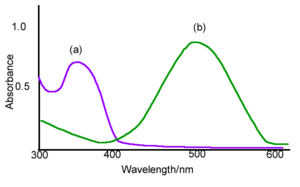Difference between revisions of "Photochromism"
Cmditradmin (talk | contribs) |
Cmditradmin (talk | contribs) |
||
| Line 13: | Line 13: | ||
A common example is the sunglasses that turn dark when exposed to sunlight. In order to qualify as photochromic the different forms of the species must have different absorption spectra. | A common example is the sunglasses that turn dark when exposed to sunlight. In order to qualify as photochromic the different forms of the species must have different absorption spectra. | ||
:<math>A \xleftarrow{n+\mu-1} B \xrightarrow[T]{n\pm i-1} C\,\!</math> | |||
Good References | Good References | ||
Revision as of 12:57, 9 June 2009
| Previous Topic | Return to Absorption and Emission Menu | Next Topic |
Definition
Photochromism is a reversible transformation of a chemical species induced in one or both directions by absorption of electromagnetic radiation between two forms, A and B, having different absorption spectra. A common example is the sunglasses that turn dark when exposed to sunlight. In order to qualify as photochromic the different forms of the species must have different absorption spectra.
- <math>A \xleftarrow{n+\mu-1} B \xrightarrow[T]{n\pm i-1} C\,\!</math>
Good References Photochromism by Brown[1]
Photochromism, Molecules, and Systems by Dürr[2]
Photochromism is derived from the Greek words: phos (light) and chroma (color). When light of wavelength lambda1 is exposed to species A it goes to B and when B is exposed to light with wavelength lambda 2 or in the presence of heat, B goes to A.
- <math>A \Leftrightarrow^{\lambda_1}_{\lambda_2, \Delta}B\,\!</math>
The example spectra of A absorbs around 350 nm and B absorbs around 500nm. One of the ways that you can control the transition is by changing the wavelength of the absorbing light, if they have different spectra. Photochromic materials are used in optical memory in which case you want A to go B and stay there. In this case it desirable that the heat driven transition from B back to A be very small.
The first report of photochromism was given by Fritzsche 1867 who observed the bleaching of an orange-colored solution of tetracene in the daylight and the regeneration of the color in the dark. [J. Fritzsche. Comptes Rendus Acad. Sci., Paris, 69,1035 (1867)]
Tetracene is a four ring conjugated colored molecule. When the crystals are exposed to sunlight the molecule is broken into the two smaller molecules neither of which absorbs in the visible also known as bleaching. There is transient bleaching, permanent or semi transient types of bleaching.
References
| Previous Topic | Return to Absorption and Emission Menu | Next Topic |
